log in
Enter site
Login to use Arthive functionality to the maximum
Victory
Rene Magritte • Malerei, 1939, 72.5×53.5 cm
Bildbeschreibung «Victory»
In his work, René Magritte repeatedly turned to depicting windows and doors, as well as other mundane objects such as closet items, fruit or flowers. Such things fascinated the artist, always in search of truth and at the same time a poetic representation of reality through art. A few years before the painting Victory, Magritte spoke of his painting The Unexpected Answer as a work that solves the "problem of the door" - that is, it answers the question of the perception of simple objects. This work develops this image, and instead of a door with a breach revealing a dark abyss before us, we see a door transferred to the shore and becoming part of the seascape.
By 1939, when Victory was created, the aim of Magritte's work was to find a hidden poetry of reality, and what he called "selective similarity" - invisible to the commonplace eye connections between objects, through which his paintings have a startling effect on us. The same impression is sometimes made on us by the juxtaposition of two seemingly incoherent words in a poem. An example of this approach, which subverts the viewer's visual conceptions, can be seen in such famous Magritte images as the caged egg, a glass of water on an umbrella or, in the case of Victory, three combined images: a seascape, an ajar door, and a cloud flying in.
The horizon line in the human mind is associated with something mysterious and mystical, and in the painting "Victory" the ajar door becomes for the viewer a guide to the place where the earth, sea and sky converge. Thus, a simple object becomes a mystical portal, no longer tangible, but materialized from sand, air and water. The same can be said about the cloud, which silently, like a ghost, flies through the doorway, inviting the viewer to enter the "enchanted area. It is the cloud that becomes the "protagonist," the key element of the painting, positioned between the two worlds and calling us to follow into one of them. Clouds have been a favorite motif of the artist, because their nature is full of mystery, but in this work, paradoxically, the weightless cloud seems to be the least mysterious element.
There are different variations of "Victory" made both in oil and in gouache.
Text prepared by Elina Bagmet
By 1939, when Victory was created, the aim of Magritte's work was to find a hidden poetry of reality, and what he called "selective similarity" - invisible to the commonplace eye connections between objects, through which his paintings have a startling effect on us. The same impression is sometimes made on us by the juxtaposition of two seemingly incoherent words in a poem. An example of this approach, which subverts the viewer's visual conceptions, can be seen in such famous Magritte images as the caged egg, a glass of water on an umbrella or, in the case of Victory, three combined images: a seascape, an ajar door, and a cloud flying in.
The horizon line in the human mind is associated with something mysterious and mystical, and in the painting "Victory" the ajar door becomes for the viewer a guide to the place where the earth, sea and sky converge. Thus, a simple object becomes a mystical portal, no longer tangible, but materialized from sand, air and water. The same can be said about the cloud, which silently, like a ghost, flies through the doorway, inviting the viewer to enter the "enchanted area. It is the cloud that becomes the "protagonist," the key element of the painting, positioned between the two worlds and calling us to follow into one of them. Clouds have been a favorite motif of the artist, because their nature is full of mystery, but in this work, paradoxically, the weightless cloud seems to be the least mysterious element.
There are different variations of "Victory" made both in oil and in gouache.
Text prepared by Elina Bagmet


